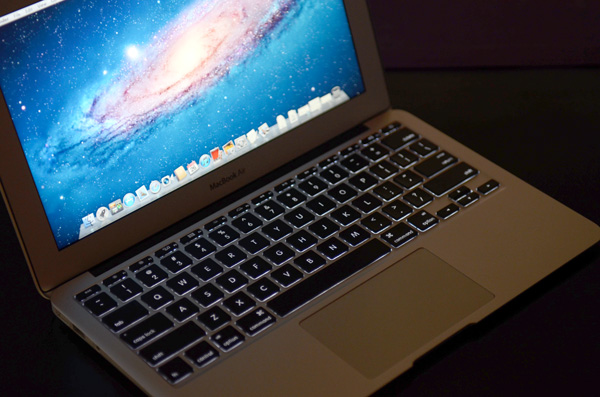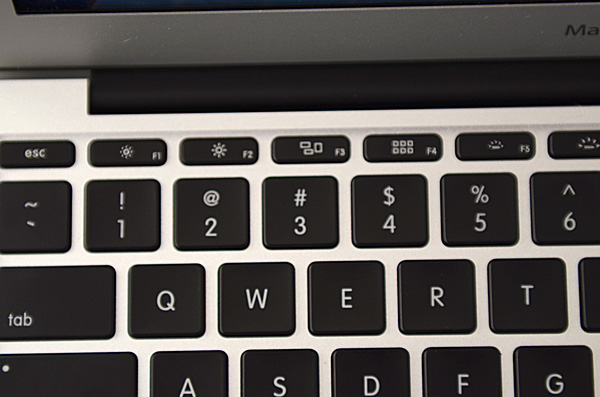The 2011 MacBook Air (11 & 13-inch): Thoroughly Reviewed
by Anand Lal Shimpi on July 28, 2011 3:25 AM EST- Posted in
- Apple
- Mac
- Intel
- Sandy Bridge
- MacBook Air
- Laptops
It's Back: The Backlit Keyboard
You knew as soon as people started complaining about it last year that Apple would have to return to a fiber optic backlit keyboard in the next MacBook Air. The 2011 models go back to their 2008 roots and both have a backlit keyboard.
The backlight functions no differently than in the MacBook Pro and is very useful for those of us who do a lot of writing at night. I lived without the backlit keyboard on last year's MacBook Air, but I always missed it.
The ambient light sensor is built into the camera assembly in the Air's bezel. Shine a bright light into that area and the keyboard backlight will turn off and the display will brighten. Conversely, cover the camera hole and the backlight will turn on and the screen will dim. You can disable each feature independently if you'd like.
Other than the backlight, the Air keyboard hasn't changed in three years. That's not to say it needs to, it's still one of my favorite keyboards. You get the same size keyboard from the 11-inch MacBook Air all the way up to the 17-inch MacBook Pro. The only difference is in the height of the function keys which are made smaller on the 11 simply due to a lack of space. Nearly every other aspect, key size, travel and feel remain unchanged between Apple's five notebooks. Maintaining consistency throughout a product line is always something Apple has excelled at.
There is one small change to the new MacBook Air keyboards - the function keys. F5 and F6 now control the brightness of the backlight, obviously absent from the previous model. There's no longer an eject button as Apple is really not expecting you to use any optical media with these new notebooks. F3 and F4 now have new functions thanks to Lion. F3 brings up Mission Control and F4 fires up Launchpad, both with sweet new pictures of each on the keys themselves.
Obviously you can map similar functionality to any function key on older Macs but it looks like this is going to be the standard Mac keyboard layout going forward. The trackpad remains unchanged in size or function from the previous MacBook Air.












103 Comments
View All Comments
tipoo - Thursday, July 28, 2011 - link
I'd like to know too, in fact I think a decibel reading for laptop reviews would be great.solatic - Thursday, July 28, 2011 - link
"... [It's] easy to imagine a future where laptops become a lot more like the new Air and shift to a couple high bandwidth ports instead of numerous lower bandwidth connections."I agree in a sense, but I very much disagree with the manner of your idea.
Getting rid of low-bandwidth ports on laptops is stupid because these low-bandwidth ports are industry standards. The standard display jack for projectors everywhere, from business rooms to classrooms etc., is VGA. Good old VGA from the 90's which was never displaced by HDMI or DVI despite their ubiquity and technological superiority. Why is irrelevant, but my point is that I can't tell you how many people I've seen with Apple laptops who time and again have asked to borrow my machine with its VGA port because they can't find their VGA dongle or forgot it at home/the office.
VGA, RJ-45, USB - we don't use these jacks because of how much bandwidth they move but because we know we will encounter devices in the field that will use them.
What you really want, Anand, is a docking station. Lenovo/IBM has/did made/make them for some time for the Thinkpad line. You come to the office, slide your laptop in, and boom - the docking connector is a high bandwidth connector that connects you to network, display, audio, interface, etc.
The only real problem with docking stations is that they're either proprietary (the Thinkpad ones) or they're too slow for higher-bandwidth applications (USB docking stations). If you see a future in Thunderbolt docking station-type devices - like the Thunderbolt display - then this is a good thing. The Thunderbolt display can now be used by any Apple computer with a Thunderbolt port - whereas Lenovo has to manufacture different docking stations for the X and T series and these docking stations can't be used with Toshibas, Apples, Dells, etc.
But to propose getting rid of VGA and RJ-45 ports now is not something I can agree with. Put Thunderbolt on new machines, make Thunderbolt projectors etc., wait for them to saturate the market - and then, only then, does it really make sense to get rid of these slower ports.
repoman27 - Friday, July 29, 2011 - link
It certainly makes sense to ditch VGA on a product like the MacBook Air, since a VGA port is too large to physically fit inside it. And it makes sense on all other laptops since most people would rather have 10 more mins of battery life all the time than a VGA port on the odd occasion that they need one. I propose that those who own archaic video devices lacking a digital interface buy a $5 adapter and leave it attached to the device, that way people with modern notebooks can connect to them without issue.The lack of a wired Ethernet port on the Airs is also due to its ultra slim profile, but it amazes me how many people I know that have no idea that they can plug their laptops into a wired network and get far better throughput. As long as WiFi offers more bandwidth than most people's ISPs, I think you can kiss that RJ45 port goodbye without upsetting too many folks.
Wolfpup - Thursday, July 28, 2011 - link
Great reviews like this are why I love this site. Super thorough and interesting on the tech, and, interesting thoughts on practical stuff too.I prefer Windows, but have been wanting a secondary Mac for a while for the heck of it. I'm SUPER torn on what to get...
The 11.6" almost seems perfect, since I can throw it in my bag with my main notebook and be okay-stick it on my desk without too much issue. But...if I ever actually used it as my primary system, the 13.3" one would be a lot more usable. And at THAT point, the 13.3" Pro is a lot more usable, and at THAT point, the 15.4" Pro isn't much larger, and completely destroys it, and of course could be my main system...
Sooooo you see my dilemma ;)
Heh...maybe I should just go with the 11 since I'm not planning on using it as my primary.
name99 - Thursday, July 28, 2011 - link
"All three parts support Hyper Threading and Quick Sync, although the latter remains mostly unused in OS X. "Quick Sync is used by iChat HD, is it not?
The other natural client for it would be AirPlay. My guess is that, come iOS5 in September, we will see AirPlay on SNB macs beefed up to be able to stream any content (not just h264) to AirPlay devices by doing the transcode transparently on Quick Sync.
The third obvious sort of client would be a library that third party apps like HandBrake would get to. What's the currents situation now --- do you need to be root to get to QuickSync or can any app use it?
My guess is that we are facing the constant problem of new "weird" hardware --- it never comes virtualizable in the first iteration, which means that there is ALWAYS the problem of how to mediate access. And we generally see the same pattern
(a) A single app that is allowed access.
(b) Some sort of library that provides its own mechanisms for mediating access.
(c) The hardware (FINALLY) becomes virtualizable.
Apple is currently at step (a). Getting to (b) is never completely trivial (in spite of the claims of no-nothings in blog comments), at least if you want to do the job properly. You have to consider questions like --- do you use a reservation model, or do you simply provide notifications when you want to grab the hardware away from a user? How easy is it juggle state and provide something that looks virtualized? etc etc.
And there are ALWAYS, at least in the first gen, weird hardware interlocks that make life more difficult. I know nothing about QuickSync but I would not be surprised if, for example, using it has implications for using the main GPU, meaning one more thing that has to be balanced in the attempt to make it used more generally.
Can someone from the Windows world (who understands these issues, and has something more useful to say than "Macs suck") tell us how QuickSync is used in the MS world? Does MS provide a general purpose library, and how does the mediation model for that library work?
name99 - Thursday, July 28, 2011 - link
Oops, my bad. The Macbook Airs apparently do not have an HD camera because it can't fit in the available depth of the thin screen. So no iChat HD on these models.I think the rest of what I said, especially about AirPlay, still stands.
rootheday - Friday, July 29, 2011 - link
The sharing/scheduling of the GPU enginers by multiple client applications on Windows is mediated by the OS as part of the WDDM driver model dating back to Windows Vista - QuickSync is no exception. This means that we are already at c) on your hierarchy on Windows with multiple client applications able to easily share the GPU for encoding.Moreover, Intel has a library already for this - see http://software.intel.com/en-us/articles/media/
The media sdk library provides an API that applications can use to perform encoding and decoding. If run on a system with QuickSync hardware support and drivers, the work is routed to the GPU. If not, the library offers a CPU fall back path. This allows ISVs to write their application once - it will just run faster on Sandybridge systems.
I don't know enough about Apple OS and graphics driver model to comment on how hard it would be for Apple to get to the same level.
jvmxtra - Thursday, July 28, 2011 - link
Thanks for the great review. I throughly enjoyed your review but I feel like one thing is missing.In fact, for a laptop review, I really want all the sites to start devoting some time and even creating a method to measure the heat that laptop brings on. We have to create some type of way to measure(benchmark?) the heat index as I feel like how hot laptop gets under certain circumstance is critical factor.
In fact, I had to trade in my 15 inch mbp since it was just getting too hot.
tipoo - Thursday, July 28, 2011 - link
The thermals and power consumption page is a start.name99 - Thursday, July 28, 2011 - link
"This is what Thunderbolt was meant to do. All we need now is widespread adoption, more accessories and a standard for external GPU form factors."AND device manufacturers who are not idiots. In particular, where are the TB hubs?
The device the market obviously wants is a TB to USB3 hub ---
two TB ports, four USB3 ports --- and yet we still have not seen this.
I'm sorry, Sonnet, but this would be VASTLY more useful than your EN and FW800 bridges.
WTF is going on?